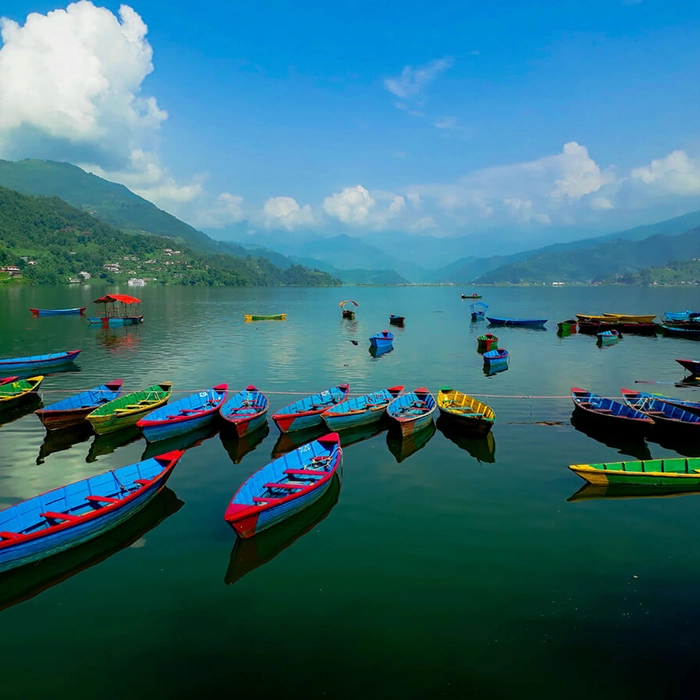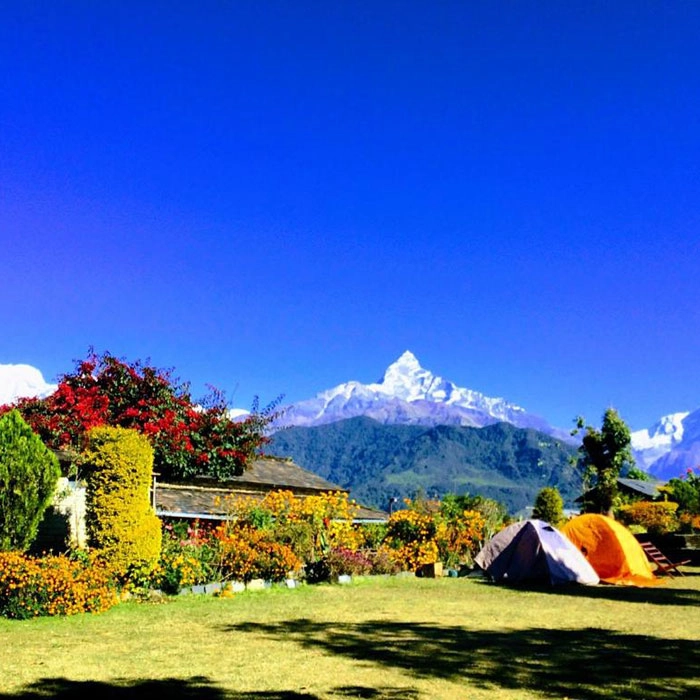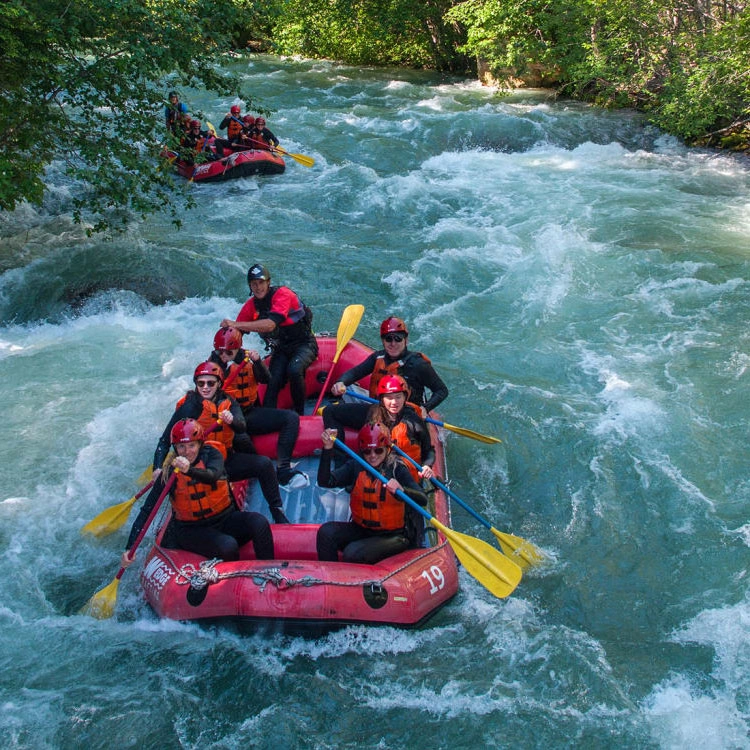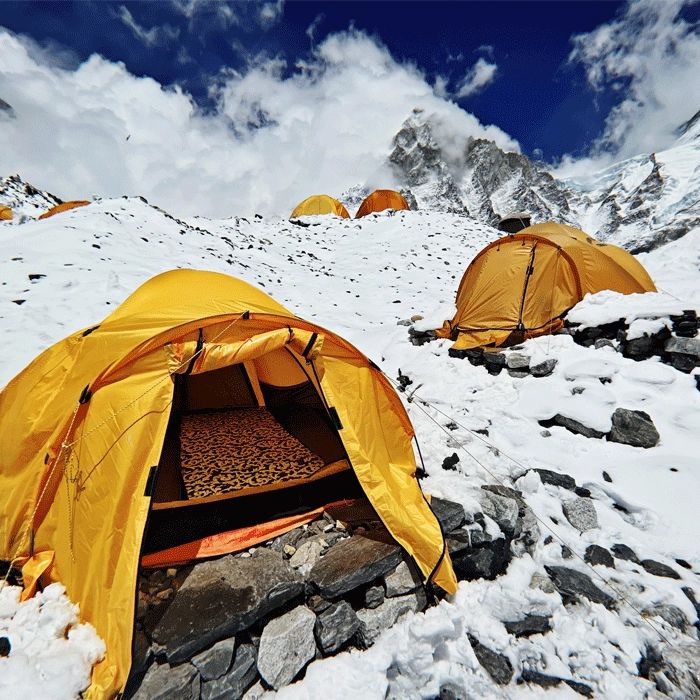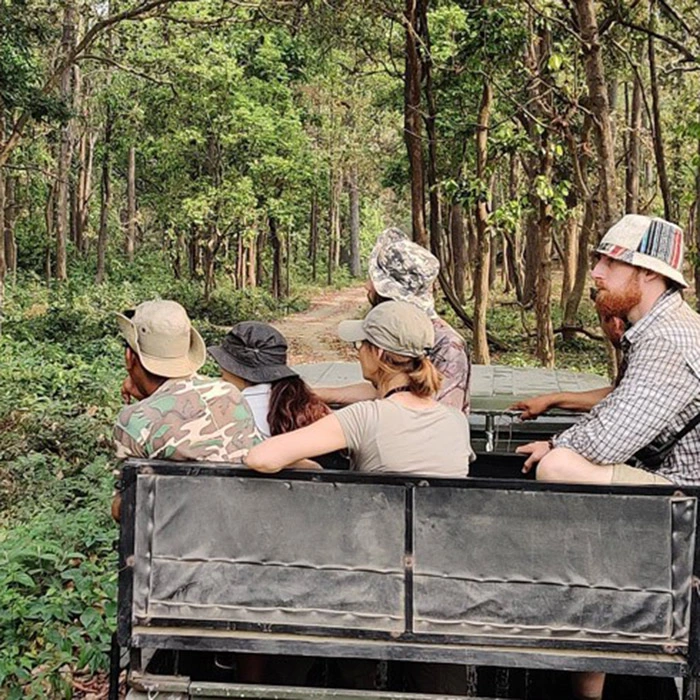ANNAPURNA BASE CAMP TREK
US$1,800.00
/pp
-
14 Days
-
Annapurna
-
Spring/Autumn
-
Trekking
-
4,130 Meters
-
Moderate
-
Bus / Plane
-
01-16 People
-
JH#201
 Overviews
Overviews
The Annapurna Base Camp Trek is a classic Himalayan journey that combines breathtaking alpine scenery, rich cultural experiences, and rewarding physical challenge. Spanning 14 days, this well-paced Annapurna Base Camp Trek itinerary guides you through the heart of Nepal’s famed Annapurna Sanctuary, surrounded by dramatic peaks like Annapurna I (8,091m), Machapuchare (Fishtail), Hiunchuli, and Annapurna South.
Starting from Pokhara, the trek winds through terraced farmlands, lush rhododendron forests, and traditional Gurung and Magar villages, offering a deep dive into local lifestyles and warm mountain hospitality. Key stops along the way in this Annapurna Base Camp Trek include Ghorepani, Poon Hill, Chhomrong, Bamboo, and Machapuchare Base Camp. A major highlight is the sunrise at Poon Hill, where you’ll witness a panoramic golden glow over the Dhaulagiri and Annapurna ranges—an unforgettable Himalayan moment.
The trail gradually ascends into alpine terrain, culminating at Annapurna Base Camp (4,130m), a natural amphitheater offering 360-degree views of towering snow-covered giants. The descent includes a relaxing stop at the Jhinu Danda hot springs and a scenic walk through Ghandruk, one of the region’s most charming mountain villages.
Designed for moderately fit trekkers, the Annapurna Base Camp Trek itinerary includes proper acclimatization and is guided by experienced professionals. With comfortable teahouse accommodations and warm Nepali meals along the way, this trek is both accessible and deeply immersive.
Whether you're a first-time trekker or a seasoned adventurer, this 14 Days Annapurna Base Camp Trek offers the perfect mix of scenic beauty, cultural depth, and trekking achievement—making it one of the most unforgettable treks in Nepal. Annapurna Base Camp DifficultyThe Annapurna Base Camp (ABC) Trek is a moderate-level trek, making it suitable for trekkers of all ages with a basic level of fitness. The trail involves daily hikes of 4 to 6 hours, passing through terraced fields, dense rhododendron forests, and traditional Gurung villages, gradually ascending to a maximum altitude of 4,130 meters (13,550 ft) at Annapurna Base Camp. While altitude is a factor, the gradual ascent allows for good acclimatization, and no technical climbing is required. With proper pacing, hydration, and preparation, even first-time trekkers can complete the ABC trek and enjoy its stunning Himalayan views and rich cultural experiences. Annapurna Base Camp CostThe Annapurna Base Camp Trek is one of the most affordable and rewarding Himalayan adventures in Nepal. The cost generally includes a licensed trekking guide, porter support, ACAP (Annapurna Conservation Area Permit), TIMS card, teahouse accommodations, daily meals during the trek, and ground transportation to and from the trailhead. Solo trekkers benefit from personalized attention, while group trekkers enjoy discounted rates, with the price per person decreasing as group size increases. We also offer special seasonal discounts during the off-peak months. While the rates shown on our website reflect standard international pricing, you’re welcome to contact us directly for customized group offers. We’re committed to providing the best possible price without compromising service quality, ensuring a safe, comfortable, and unforgettable Annapurna Base Camp trekking experience.
 Itinerary (Plan)
Itinerary (Plan)
Arrive in Kathmandu (1,400 m / 4,593 feet), Nepal's vibrant capital, where you'll be warmly welcomed with marigold garlands. After transferring to your hotel, take time to relax and acclimate to the bustling city. Discover vibrant local markets, indulge in traditional Nepali dishes, and delve into Kathmandu's rich cultural tapestry. This initial day is perfect for easing into your journey, setting the stage for the exciting adventures ahead in Eastern Nepal. A representative from Jagadamba Holidays will ensure a smooth and pleasant arrival.
Optional Evening Activity:
If you wish, you can spend your evening experiencing the Pashupatinath Aarti, a captivating religious ceremony held at the Pashupatinath Temple. The Aarti usually begins around 6:00 PM and lasts for approximately an hour. This ceremony is a mesmerizing display of traditional music and rituals, providing a profound insight into Hindu spiritual practices. Please check the exact time for the Aarti on the day of your visit, as it may vary. This option is not included in the standard itinerary but offers a unique opportunity to immerse yourself in local culture.
Your journey begins with a scenic drive to Pokhara (822 m / 2,697 ft.), a picturesque city nestled beside the serene Phewa Lake. The drive typically takes around 6-7 hours, covering approximately 200 kilometers from Kathmandu. For a more time-efficient and scenic travel experience, consider opting for a short 30-minute flight from Kathmandu to Pokhara instead of the 6-7 hour drive. This premium option, available at an additional cost, offers a breathtaking aerial view of the Himalayan landscape, ensuring a more comfortable and memorable journey.
As you leave the bustling capital, the road winds through lush green hills, terraced farmlands, and charming villages, offering a glimpse of rural Nepalese life. Enjoy the tranquil atmosphere of Pokhara, with the majestic Annapurna range standing tall in the backdrop. This city is the gateway to your trekking adventure, so take time to relax and prepare for the thrilling days ahead.
After breakfast at the hotel, meet your guide and porter, then begin a picturesque drive from Pokhara to Hile Village (1,430 m / 4,692 ft). The scenic drive winds through lush green valleys, vibrant terraced fields, and traditional rural villages, offering travelers a glimpse of authentic Himalayan village life. Along the way, you’ll pass Birethanti (1,025 m / 3,363 ft), local markets, traditional houses, and small rivers, capturing the essence of Nepalese culture. The journey features several viewpoints perfect for photos, making it a memorable start to your Annapurna trek.
The trek from Hile to Ulleri (1,960 m / 6,430 ft) covers approximately 3 km (1.9 mi) and usually takes 3–4 hours, leading trekkers through forested slopes, terraced farmland, and quaint villages while gradually ascending to Ulleri. During this section, you’ll ascend about 550 m and descend roughly 10 m. The trail begins with a steady climb through hills and villages, culminating in a steep ascent via stone steps—an invigorating introduction to the Annapurna trekking adventure.
Nestled in the Annapurna region, Ulleri is a refreshing rest stop, offering cozy teahouses and the warmth of local hospitality. Along the trail, you’ll pass terraced fields, forested slopes, and traditional villages, experiencing the daily life of local communities. Observe farmers at work, visit small temples, and enjoy glimpses of local culture. Upon reaching Ulleri, take in panoramic views of Annapurna South (7,219 m / 23,684 ft) and Hiunchuli (6,441 m / 21,132 ft) peaks, soaking in the tranquil Himalayan environment and preparing for the days of trekking in Annapurna ahead.
Your trek to Ghorepani begins with a challenging ascent, climbing over 1,000 stone steps from Ulleri (1,960 m / 6,430 ft). This initial climb is a true test of stamina, but it also provides an invigorating start to the day as you gain altitude and gradually leave the village landscape behind.
The trail stretches over 8 kilometers, taking around 4–5 hours to complete at a steady pace. During this section, you’ll ascend about 840 meters and descend approximately 30 meters, steadily making your way higher into the Annapurna region. The path transitions from open terraced fields into thick forests, creating a beautiful contrast as the scenery changes with elevation.
As you continue, the trek leads through enchanting rhododendron forests, which come alive with vibrant red, pink, and white blossoms during spring (March–April), making this section one of the most magical along the entire trek. The cool shade of the forest, accompanied by the sounds of birds and flowing streams, offers a peaceful atmosphere to balance the uphill effort. On clear days, occasional openings in the trees reveal breathtaking views of Annapurna South, Machapuchare (Fishtail), and Hiunchuli in the distance.
Approaching Ghorepani (2,860 m / 9,383 ft), the air grows crisper and the Himalayan panoramas more dramatic. Ghorepani is a lively trekking hub, well-known for its traditional teahouses, warm hospitality, and stunning mountain backdrop. From here, trekkers gain easy access to Poon Hill (3,210 m / 10,531 ft), one of the most famous viewpoints in Nepal.
Tomorrow promises an unforgettable highlight: an early morning hike to Poon Hill, where you’ll witness the legendary sunrise over the Annapurna and Dhaulagiri ranges, with golden light spilling across the Himalayas—an experience cherished by trekkers worldwide.
Wake up early in the morning for your Poon Hill sunrise excursion. This hike may be short, but it’s one of the most unforgettable highlights of the Poon Hill trek in the Annapurna region. As you ascend in the dark with your headlamp, anticipation builds with every step. The hike to Poon Hill (3,210 m / 10,531 ft) takes around 45 minutes to 1 hour each way, making it approximately a 2.75 km round trip with a 270 m ascent and descent. At the top, you’ll be greeted by a crowd of fellow trekkers gathered to witness one of the most iconic spectacles in the Himalayas.
From the summit, enjoy the breathtaking panoramic sunrise views as the first golden light of day spreads across the Annapurna and Dhaulagiri ranges, including Annapurna South, Hiunchuli, Machapuchare (Fishtail), Dhaulagiri, and Nilgiri. The snowcapped peaks gradually change colors, glowing orange and gold in the morning light—a truly unforgettable moment. Your guide will suggest the best wake-up time based on the season to ensure you don’t miss this once-in-a-lifetime view.
After soaking in the sunrise, descend back to Ghorepani and enjoy a hearty breakfast at your lodge. Re-energized, begin your trek from Ghorepani to Tadapani (2,630 m), enjoying scenic Himalayan views along the way.
The trail from Ghorepani to Tadapani is about 8 km, typically taking 5–6 hours to complete. The route involves an ascent of 460 m and descent of 650 m, making it a moderately challenging day. The path leads you through dense rhododendron and oak forests, especially vibrant in spring when the hillsides are painted red and pink with blossoms. You’ll also pass through scenic ridgelines, quiet streams, and occasional open clearings that reveal dramatic Himalayan vistas.
As you approach Tadapani, the air grows cooler and the forest more serene. Tadapani is a tranquil mountain village, surrounded by greenery and blessed with stunning views of Annapurna South, Hiunchuli, and Machapuchare. It’s the perfect place to rest after a rewarding day’s trek, enjoy local hospitality, and prepare for the next stage of your Annapurna journey.
After breakfast at your lodge in Tadapani, begin your trek toward Chhomrong (2,178 m / 7,142 ft), a charming village nestled in the lap of the Annapurna range. The trail offers a mix of natural beauty and cultural experiences as you descend through lush forests, cross sparkling streams, and pass traditional Himalayan villages along the way. The journey provides travelers with an authentic glimpse of Himalayan village life, local terraced fields, and the surrounding mountain scenery, making it a truly memorable segment of the Annapurna Base Camp trek.
The trek from Tadapani to Chhomrong stretches approximately 9 kilometers and typically takes around 5–6 hours to complete, depending on pace and stops for photography or rest. During this section, trekkers will experience an elevation ascent of 390 meters and a descent of 880 meters, making it a moderately challenging day with a mix of uphill and downhill walking. The mix of uphill climbs and downhill stretches makes this trek rewarding, with stunning views of the Annapurna and Machhapuchhre (Fishtail) ranges around every turn.
The trail begins with a steep descent to Kimrong Khola, followed by a gradual ascent toward Chhomrong (2,178 m / 7,142 ft). Along the trail, you’ll wander through dense rhododendron and oak forests, cross charming suspension bridges, and stroll past vibrant terraced fields cultivated by local farmers. Chhomrong serves as the last major village on the trail to Annapurna Base Camp, providing trekkers with a perfect place to rest, enjoy local hospitality, and take in panoramic views of Machhapuchhre (Fishtail) and Annapurna South. Its strategic location makes it a key stopover for trekkers, combining cultural experiences with stunning natural beauty.
After breakfast at your lodge in Chhomrong (2,178 m / 7,142 ft), begin your trek toward Dovan (2,600 m / 8,530 ft), a peaceful settlement nestled in the lap of the Annapurna range. Along the trail, you’ll pass through charming Himalayan villages like Sinuwa and Bamboo, where terraced fields and traditional homes showcase local mountain life. This section of the trek immerses you in authentic Nepalese mountain culture, offering opportunities to observe farmers at work, small temples, and traditional village life. The journey also showcases the lush forests and dramatic landscapes of the Annapurna region, making it a memorable part of the Annapurna Base Camp trek.
The trek from Chhomrong to Dovan spans approximately 10 kilometers and typically takes 5–6 hours to complete. During this segment, trekkers will experience an elevation ascent of 750 meters and a descent of 420 meters, with a mix of uphill and downhill sections that gradually prepare you for the higher altitudes ahead. The trail begins with a descent from Chhomrong to Chhomrong Khola, followed by a steady climb through dense bamboo and rhododendron forests, creating a serene and refreshing trekking environment.
As you ascend, the sound of the rushing Modi Khola River accompanies you, adding a tranquil soundtrack to your trek. The elevation gain is gradual, eventually reaching Dovan (2,600 m / 8,530 ft), a small settlement surrounded by forests and offering a peaceful retreat after a rewarding day of trekking. Today’s altitude gain is important as it helps your body acclimatize while preparing for the higher elevations to come, making Dovan a crucial stop on the journey toward Annapurna Base Camp.
After breakfast at your lodge in Dovan (2,600 m / 8,530 ft), begin your trek toward Machhapuchchhre Base Camp (MBC) (3,700 m / 12,139 ft), one of the most exhilarating highlights of your Annapurna trek. The trail leads through increasingly rugged terrain, offering a mix of natural beauty and the thrill of ascending to higher altitudes. As you progress, you’ll pass through open hillsides, patches of sparse forest, and rocky outcrops, with panoramic views of the surrounding Annapurna and Machhapuchchhre (Fishtail) ranges unfolding around every bend. This segment provides a truly immersive Himalayan experience, combining adventure, breathtaking scenery, and a sense of accomplishment.
The trek from Dovan to Machhapuchchhre Base Camp covers approximately 9 kilometers and typically takes 5–6 hours, depending on pace and rest stops. During this section, trekkers will experience a substantial elevation gain of 1,200 meters and a slight descent of 20 meters, making it a challenging but rewarding day. The steep ascent demands stamina, but each step brings increasingly dramatic views of the snowcapped peaks, glaciers, and ridgelines that define the Annapurna region.
The trail ascends steadily, and as you climb higher, vegetation becomes sparse and the landscape more rugged, highlighting the raw beauty of the high Himalayas. Towering above is Machhapuchchhre (Fishtail Mountain), its distinctive double summit forming a dramatic and iconic feature of the skyline. Reaching Machhapuchchhre Base Camp (3,700 m / 12,139 ft), you’ll find yourself surrounded by majestic Himalayan peaks, crisp mountain air, and panoramic vistas that are nothing short of awe-inspiring. This is one of the most memorable points of your trek, offering unparalleled photographic opportunities and a deep sense of connection with the Annapurna mountains.
After a refreshing morning at Machhapuchchhre Base Camp (MBC) (3,700 m / 12,139 ft), continue your trek toward Annapurna Base Camp (ABC) (4,130 m / 13,549 ft), one of the ultimate highlights of your Annapurna trek. Though relatively short, this trek involves a significant elevation gain, making it both challenging and immensely rewarding. The trail winds steadily upward, offering dramatic Himalayan scenery at every turn, from rocky ridgelines to patches of high-altitude vegetation, gradually preparing trekkers for the higher altitude and thin mountain air.
The trek from MBC to ABC covers approximately 3 kilometers and usually takes 1–2 hours, depending on pace and rest stops. During this section, trekkers will experience an elevation ascent of 450 meters, with virtually no descent, as the trail steadily climbs toward the heart of the Annapurna Sanctuary. Every step brings you closer to the spectacular peaks that surround Annapurna Base Camp, creating a sense of anticipation and excitement as you near your destination.
The trail gradually ascends, and as you approach Annapurna Base Camp (4,130 m / 13,549 ft), the landscape opens dramatically, revealing a panoramic ring of towering Himalayan peaks, including Annapurna I, the 10th highest mountain in the world, along with Hiunchuli, Machhapuchhre (Fishtail), Annapurna South, and Gangapurna. At ABC, trekkers are rewarded with some of the most breathtaking mountain vistas in the Himalayas, a pristine high-altitude environment surrounded by snow-capped peaks, glaciers, and moraine-strewn terrain.
Arriving at Annapurna Base Camp (4,130 m / 13,549 ft) represents a pinnacle of achievement on the Annapurna Base Camp trek. The site is encircled by majestic Himalayan peaks, including Annapurna I, Machhapuchhre (Fishtail), Hiunchuli, and Annapurna South, providing panoramic vistas of extraordinary scale and beauty. The crisp mountain air, snow-capped ridges, and rugged terrain create a remarkable high-altitude environment. Annapurna Base Camp affords excellent opportunities for photography, contemplation, and appreciation of the Himalayas. The surrounding Annapurna Sanctuary, glaciers, and high-altitude landscapes further enhance the experience, establishing ABC as an essential and unforgettable destination for serious trekkers in Nepal.
After witnessing a stunning sunrise at Annapurna Base Camp (4,130 m / 13,549 ft), begin your descent toward Bamboo (2,310 m / 7,579 ft), retracing parts of the path you previously ascended. This descent provides an entirely new perspective on the Annapurna Sanctuary, allowing trekkers to appreciate the grandeur of the Himalayan peaks, deep valleys, and high-altitude landscapes from a different angle. As you navigate the trail, notice how the morning light illuminates the glaciers, ridges, and forests, creating spectacular photo opportunities and a serene, reflective trekking experience.
The trek from ABC to Bamboo spans approximately 14 kilometers and typically takes 6–7 hours to complete. During this segment, trekkers encounter a modest elevation ascent of 10 meters but a substantial descent of 1,800 meters, making it a long, challenging, yet immensely rewarding day of trekking. The gradual yet continuous downhill demands focus and endurance, providing a perfect balance between effort and breathtaking scenery.
The descent is significant, offering ever-changing vistas of the surrounding Himalayan peaks, deep valleys, and the iconic Annapurna Sanctuary. Along the way, you’ll pass familiar landmarks such as Machhapuchchhre Base Camp (MBC), Deurali, and Dovan, each revealing a fresh perspective on the rugged terrain and high-altitude landscapes you previously navigated. The trail meanders through alpine meadows, dense rhododendron and oak forests, and follows the Modi Khola river, creating a peaceful and scenic environment as you descend toward lower elevations.
Arriving at Bamboo, a small settlement tucked within lush forests, trekkers are greeted with cozy lodges, warm local hospitality, and a much-needed opportunity to rest after the long descent. While descending eases the strain on your lungs, the steep downhill sections can be tough on the knees, so it is advisable to move steadily, pause frequently, and fully take in the changing landscapes. This stage of the trek provides an immersive experience in the Annapurna region, combining natural beauty, high-altitude scenery, and the satisfaction of progressing further along the Annapurna Base Camp trek, setting the tone for the upcoming journey toward lower elevations.
After a refreshing morning at Bamboo (2,310 m / 7,579 ft), continue your trek toward Jhinu Danda (1,780 m / 5,840 ft), one of the most exhilarating up-and-down trekking experiences on the Annapurna Base Camp trek. Jhinu Danda, culminating in a relaxing retreat at the village’s famous natural hot springs, offers trekkers the perfect opportunity to unwind after a long day.
Though relatively short, this trek involves a significant elevation change, making it both challenging and immensely satisfying. The trail winds steadily upward at intervals and descends through verdant valleys, combining scenic landscapes, traditional Himalayan villages, and refreshing high-altitude forest trails. Along the way, enjoy spectacular views of the surrounding Annapurna and Machhapuchhre (Fishtail) ranges, observe local village life and terraced fields, and take in dramatic Himalayan scenery at every turn—from rocky ridgelines to patches of high-altitude vegetation. Each step provides changing perspectives of the Annapurna Sanctuary and surrounding peaks, creating a fully immersive and rewarding trekking experience.
The trek from Bamboo to Jhinu Danda covers approximately 11 kilometers and usually takes 5 to 6 hours to complete, offering trekkers a fulfilling journey through the scenic Annapurna landscapes. Trekkers encounter an elevation ascent of 470 meters and a significant descent of 1,050 meters, making it a moderately challenging day with a rewarding downhill journey. The trail demands careful footing on steeper sections but rewards trekkers with ever-changing vistas, shaded rhododendron and oak forests, flowing streams, and glimpses of authentic Nepalese mountain life.
The trail begins with a short ascent to Khuldighar, followed by a steep descent to the Chhomrong Khola. After crossing the river via suspension bridge, the path climbs again to reach the village of Chhomrong, a bustling Himalayan settlement and key stopover on the Annapurna Base Camp trek. From Chhomrong, the trail continues with a final steep descent to Jhinu Danda, where the altitude gradually drops, providing a well-earned respite for tired legs. The total elevation loss today is considerable, combining challenging descents with moderate climbs that keep the trek dynamic.
Upon reaching Jhinu Danda, trekkers are rewarded with the opportunity to soak in the natural hot springs, located just a short walk from the village. The warm, mineral-rich waters soothe sore muscles and rejuvenate the body after days of trekking. Jhinu Danda also offers stunning views of surrounding hills, terraced valleys, and distant peaks, making it an ideal place to relax, reflect on the journey, and enjoy the unique blend of natural beauty and local Himalayan culture that defines the Annapurna region.
After breakfast at Jhinu Danda (1,780 m / 5,840 ft), begin the final leg of your Annapurna Base Camp trek, descending toward Siwai. This section marks the conclusion of your high-altitude adventure, offering a serene and reflective journey through the lower Annapurna valleys. The trail gradually descends, allowing trekkers to enjoy changing landscapes, from lush forests to terraced fields, while soaking in the peaceful ambiance of rural Himalayan life.
The trek covers approximately 8 kilometers and typically takes 3–4 hours. During this segment, trekkers experience a gradual elevation decrease of around 250 meters, making the descent gentle yet engaging. The trail winds through verdant forests, charming villages, and picturesque farmlands, providing a final opportunity to connect with local culture and observe traditional Nepalese mountain life.
Once you arrive in Siwai, you’ll embark on a scenic drive back to Pokhara, a journey of about 54 kilometers that typically takes 2–3 hours, offering picturesque views of valleys and rivers along the way. Arriving at Pokhara (822 m / 2,697 ft), enjoy the remainder of the day relaxing by Phewa Lake, exploring the vibrant lakeside area, or visiting local cafés and markets. This is an ideal moment to reflect on your trekking journey, savor the tranquil surroundings, and celebrate the successful completion of the Annapurna Base Camp trek before returning to Kathmandu.
Pokhara, often called the “Gateway to the Annapurna region,” offers a perfect blend of natural beauty and cultural charm. The city is renowned for its serene lakes, panoramic Himalayan views, and vibrant lakeside markets. Visitors can enjoy boat rides on Phewa Lake, stroll along the bustling lakeside promenade, or relax at a café while watching the sunset over the snow-capped peaks. Pokhara provides a peaceful and picturesque setting to unwind, making it an ideal conclusion to your Annapurna trekking adventure.
Your adventure concludes with a luxurious and scenic drive from Pokhara to Kathmandu on a deluxe tourist bus. Covering approximately 200 kilometers in 6–7 hours, this comfortable journey takes you through verdant hills, winding roads, and alongside the Trishuli River, offering stunning views of Nepal’s diverse landscapes.
As you depart from the lake city of Pokhara, the gateway to the Annapurna region, you’ll pass through traditional Nepali villages, terraced fields, and lush valleys before arriving in Kathmandu, the bustling temple city rich in history, culture, and heritage.
This final leg of your Annapurna Base Camp Trek is not just a return trip but a last chance to embrace Nepal’s natural beauty and cultural essence. Upon reaching Kathmandu, spend your time exploring UNESCO World Heritage Sites, shopping for handmade souvenirs, or simply relaxing and reflecting on your unforgettable Himalayan trekking adventure.
Concluding Your Journey in Nepal
As your remarkable journey through the Himalayas comes to an end, take a moment to reflect on the awe-inspiring natural beauty, rich cultural heritage, and memorable experiences that have defined your time in Nepal. From the majestic mountain landscapes to the warm hospitality of the local communities, every moment has contributed to an unforgettable adventure.
Airport Transfer by Jagadamba Holidays
To ensure a smooth and timely departure, an official representative from Jagadamba Holidays will collect you from your hotel 3.5 hours prior to your scheduled flight departure. Our team is committed to providing a reliable and comfortable transfer service to Tribhuvan International Airport, allowing you to conclude your journey with peace of mind.
We sincerely appreciate your trust in Jagadamba Holidays and hope to have the pleasure of serving you again on your future journeys.
Quotation 2025
| Group Size (Pax) |
1 - 2 |
3 - 4 |
5 - 6 |
7 - 8 |
9 - 12 |
13 - 16 |
17 - 20 |
21 - 24 |
25 - 32 |
| Cost Per Person |
$1,620 |
$1,590 |
$1,560 |
$1,530 |
$1,500 |
$1,570 |
$1,440 |
$1,410 |
$1,380 |
 Cost Include
Cost Include
- All transfers within Nepal are included as per itinerary
- Any domestic flight of Nepal as per trekking itinerary
- Trekking accommodation (hotel, lodge and/or tent) as per itinerary
- Small shared room with shared bathroom during trek in Nepal
- In Kathmandu and/or Pokhara: Stay at ***Hotel with breakfast
- Luggage for porters during the trek (12.5 kg/person)
- 3 meals (Breakfast, Lunch and Dinner) during the trek
- Unlimited tea or coffee for breakfast during the trek
- An English speaking guide (trekking/tour) as per Itinerary
- Travel insurance for trekking staff (guides and porters)
- All expenses of trekking staff(s) during trekking
- Includes all conservation, national park, trekking, and climbing permits
- Sightseeing / Wildlife tours if included in the itinerary
- Farewell dinner in Kathmandu before returning home
 Cost Exclude
Cost Exclude
- Single room/single tent surcharge (on request)
- Round trip/one way international flight ticket to Nepal.
- Tourist visa for Nepal (30-50 $, depending on length of stay)
- Personal Insurance (covers: Trip/flight cancellation, helicopter rescue)
- Meals (lunch, dinner) at hotels in Kathmandu, Pokhara and other cities
- Drinks (soft, hot or mineral/boiled water) during the lodge trek
- Any personal trekking and/climbing equipment for trekking in Nepal
- Hotel expenses in case of early return from trekking for any reason
- Costs due to flight cancellations & extra porters/horses during the trek
- Additional costs incurred due to any reason beyond Jagdamba’s control
- More evidence about pandemics like COVID-19 if needed in the future.
- Personal expenses during the trek (phone, wifi, shower, charging etc.)
- Other costs and things that are not mentioned in the service inclusion
- Gratuity for trekking staff (recommended: 9€ /10$ per traveler per day)
|







 Overviews
Overviews
 Trip Overview
Trip Overview

 Travel Itinerary
Travel Itinerary
 Cost Include
Cost Include
 Cost Exclude
Cost Exclude
 Fixed Departure
Fixed Departure
 Route Map
Route Map

 Freqeuntly Asked Questions
Freqeuntly Asked Questions
 Reviews And Rating
Reviews And Rating
